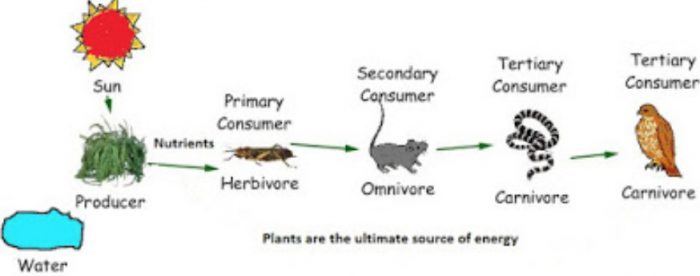NCERT Solutions for Chapter 1 Nutrition In Plants for Class 7
Question 1. Why do organisms take food?
Answer All organisms need to take food to get energy for the growth, development, maintenance of their bodies, it provides immunity against diseases etc.
2. Distinguish between a parasite and a saprotroph?
Answer
| Parasite | Saprophyte |
| They feed on living organism. | They feed on dead and decaying organism. |
| They use intracellular digestion. | They use extracellular digestion. |
| For ex: Cuscuta | For ex: Mushroom, bacteria |
Question 3. How would you test the presence of starch in leaves?
Answer
Take a green potted plant. Keep the plant in a dark room for two to three days so that all the starch gets used up. Now cover a portion of leaf with a black strip paper and keep the plant in sunlight for about six hours. Pluck the leaf from the plant. Dip the leaf in boiling water for a few minutes. After this, immerse it in a beaker containing alcohol. Now dip the leaf in a dilute solution of iodine for a few minutes. Take out the leaf and rinse off the iodine solution. You observe that the presence of starch in various areas of the leaf which was uncovered. Iodine test is used to detect the presence of starch in leaves.
Question 4. Give a brief description of the process of synthesis of food in green plants.
Answer
Green plants synthesise their own food by the process of photosynthesis. The leaves have a green pigment called chlorophyll which helps them to capture the energy of the sunlight. In the presence of sunlight, carbon dioxide and water combine to form glucose and oxygen is released.
Question 5. Show with the help of a sketch that plants are the ultimate source of food.
Answer 5
Question 6. Fill in the blanks:
(a) Green plants are called _________________ since they synthesise their own food.
(b) The food synthesised by plants is stored as _________________.
(c) In photosynthesis solar energy is absorbed by the pigment called ___________.
(d) During photosynthesis plants take in ______ and release________ gas.
Answer
(a) Green plants are called autotrophs since they synthesise their own food.
(b) The food synthesised by the plants is stored as starch.
(c) In photosynthesis solar energy is captured by the pigment called Chlorophyll.
(d) During photosynthesis plants take in carbon dioxide and release oxygen gas.
Question 7. Name the following:
(i) A parasitic plant with yellow, slender and branched stem.
(ii) A plant that is partially autotrophic.
(iii) The pores through which leaves exchange gases.
Answer
(i) A parasitic plant with yellow, slender and tubular stem – Cuscuta
(ii) A plant that is partially autotrophic – Pitcher plant, Venus flytrap.
(iii) The pores through which leaves exchange gases – Stomata
Question 8. Tick the correct answer:
(a) Amarbel is an example of:
(i) autotroph (ii) parasite (iii) saprotroph (iv) host
(b) The plant which traps and feeds on insects is:
(i) Cuscuta (ii) china rose (iii) pitcher plant (iv) rose
Answer 8
(ii) parasite
(iv) pitcher plant
Question 9. Match the items given in Column I with those in Column II:
Column I Column II
Chlorophyll Rhizobium
Nitrogen Heterotrophs
Cuscuta Pitcher plant
Animals Leaf
Insects Parasite
Answer
Column I Column II
Chlorophyll Leaf
Nitrogen Bacteria
Cuscuta Parasite
Animals Heterotrophs
Insects Pitcher plant
Question 10. Mark ‘T’ if the statement is true and ‘F’ if it is false:
(i) Carbon dioxide is released during photosynthesis. (T/F)
(ii) Plants which synthesise their food are called saprotrophs. (T/F)
(iii) The product of photosynthesis is not a protein. (T/F)
(iv) Solar energy is converted into chemical energy during photosynthesis. (T/F)
Answer
(i) Carbon dioxide is released during photosynthesis. (False)
(ii) Plants which synthesise their food themselves are called saprotrophs. (False)
(iii) The product of photosynthesis is not a protein. (True)
(iv) Solar energy is converted into chemical energy during photosynthesis. (True)
Question 11. Choose the correct option from the following:
Which part of the plant takes in carbon dioxide from the air for photosynthesis?
(i) Root hair (ii) Stomata (iii) Leaf veins (iv) Petals
Answer Stomata
Question 12. Choose the correct option from the following:
Plants take carbon dioxide from the atmosphere mainly through their:
(i) roots (ii) stem (iii) flowers (iv) leaves
Answer Leaves
Question 13. Why do farmers grow many fruits and vegetable crops inside large green houses? What are the advantages to the farmers?
Answer Fruit and vegetable crops may develop more quickly by being grown within huge greenhouses where the weather, temperature, and growing seasons can all be controlled. This procedure can also be used to protect crops from insects and pests.


thank you for giving these answers
the answers came out very usefull . thank you . over it was very usefull and.
Impressive! Thanks for the post